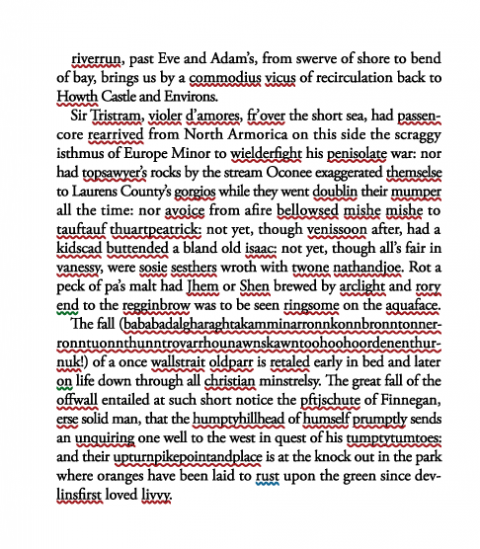Reading James Joyce’s Ulysses is no walk in the park. Why else would so many people falsely claim to have read it. (See our post from last week, 20 Books People Pretend to Read.) But Finnegans Wake is a whole ‘nother deal. Joyce’s final work is considered one of the most difficult works of fiction ever written, and contrary to Ulysses, the novel “has some claim to be the least read major work of Western literature,” according to Joyce scholar Lee Spink. Put simply, people don’t even bother reading … or pretending to read … Finnegans Wake (unless, of course, they live in China, where the novel reached the #2 position on a Shanghai bestseller list earlier this year.)
But I digress: why don’t readers even give Finnegans Wake a shot? The illustration above perhaps says it all. The web site stammpunct.com has created a visual showing what happens when you run a page of the novel through a spell checker. It yields a lot of red, and then some more red. A framable print of this visual can be purchased at stammpunct for $35.
Copies of Ulysses and Finnegans Wake can be downloaded from our collection of Free eBooks. And you can hear James Joyce reading ‘Anna Livia Plurabelle’ from Finnegans Wake here. It was recorded in 1929.
via The Paris Review
Related Content:
Hear James Joyce Read From his Epic Ulysses, 1924
Henri Matisse Illustrates 1935 Edition of James Joyce’s Ulysses
Stephen Fry Explains His Love for James Joyce’s Ulysses
Marilyn Monroe Reads Joyce’s Ulysses at the Playground (1955)



I’m amazed it was published in that state.
$35 for the print would be “buttended” enough, but it’s actually $50.
Was this author executed for his crimes, or did he receive medical care?
When will we see a Joyce class in the literature section??? Trying to wait patiently…
If I recall correctly, Joyce wrote Finnegan’s to be akin to the dream state of consciousness.
Scott, you recall correctly. Ulysses was to be the book of the day, Finnegans Wake the book of the night. It’s also meant to encode a number of myths through the language instead of just through allusion and allegory. It’s also meant to be read aloud; many of the double (triple, more) meanings are aural as well as visual.
Sam Beckett wrote a decent intro of what Joyce was up to in his essay “Dante… Bruno. Vico.. Joyce” — it’s easy enough to find online. Beckett was helping Joyce at the time in Paris, and bits of the Wake were being serialized, to decidedly mixed reception. The gist of Beckett’s essay concerns how at that time, the art world was telling itself it was becoming more concerned with the divide between form and content, and if/how that could be overcome. Beckett argued that in the Wake, form was content, and vice-versa — and the mandarins of literature who were having discussions about how that could happen didn’t see it when it was in front of their faces. (Very Irish, that.)
no , he was immortalized with bronze statues and countless discussion. He spend 17 years on this. Any geek can spell.